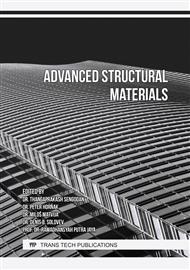p.161
p.167
p.175
p.183
p.191
p.197
p.203
p.209
p.215
New Thermal Insulation Materials from Waste of Mechanical Processing of Wood
Abstract:
The article describes the conditions for obtaining new thermal insulation materials from the waste of mechanical processing of soft hardwood wood. The recommendations for the production of new resource-saving technologies of gypsum-wood and chip-and-glue composites are justified, which makes it possible to dispose of waste from the processing of soft hardwood wood. It was found that the birch pulp extract, along with cellulose and lignin, contains d-erythrosis, which is easily washed out of the wood with water or a solution of "mineralizer" and gets into the cement dough, which leads to a slowdown in hardening and a decrease in compressive strength. It is shown that the existing technological processes for eliminating the negative influence of saccharides on the strength of wood aggregate composites are complex, requiring multi-stage treatment of the aggregate with various chemicals or long-term exposure. A method based on the use of binders that do not interact with extractable substances, such as gypsum or urea-formaldehyde glue, is proposed. By scanning electron microscopy, it was found that the structure of the gypsum-wood composite varies depending on the sequence of input components. The nature of the effect of microcrystalline cotton cellulose on the change in the physical and mechanical properties of the gypsum-particle composite using cavitation-treated sawdust was revealed and its optimal dosage was determined. The regression dependences of the influence of the consumption of wood chips and glue on the compressive strength of the chip-and-glue composite were obtained by the experimental planning method.
Info:
Periodical:
Pages:
197-202
Citation:
Online since:
March 2023
Authors:
Price:
Сopyright:
© 2023 Trans Tech Publications Ltd. All Rights Reserved
Share:
Citation:


